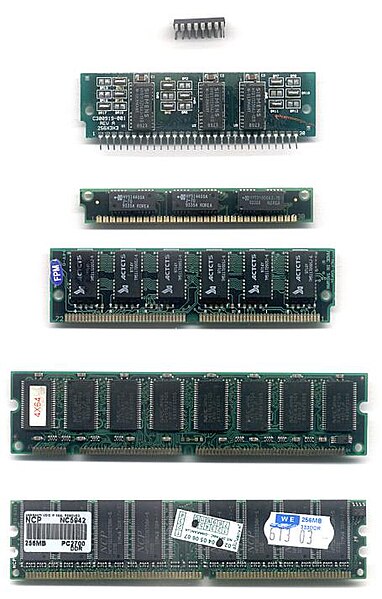Learning Resources
DRAM
Dynamic random-access memory (DRAM) is a type of random-access memory that stores each bit of data in a separate capacitor within an integrated circuit. The capacitor can be either charged or discharged; these two states are taken to represent the two values of a bit, conventionally called 0 and 1. Since capacitors leak charge, the information eventually fades unless the capacitor charge is refreshed periodically. Because of this refresh requirement, it is a dynamic memory as opposed to SRAM and other static memory.
The main memory (the "RAM") in personal computers is dynamic RAM (DRAM). It is the RAM in laptop and workstation computers as well as some of the RAM of video game consoles.
The advantage of DRAM is its structural simplicity: only one transistor and a capacitor are required per bit, compared to four or six transistors in SRAM. This allows DRAM to reach very high densities. Unlike flash memory, DRAM is volatile memory (cf. non-volatile memory), since it loses its data quickly when power is removed. The transistors and capacitors used are extremely small; billions can fit on a single memory chip.
DRAM is usually arranged in a rectangular array of charge storage cells consisting of one capacitor and transistor per data bit. Modern DRAM matrices are many thousands of cells in height and width.
The long horizontal lines connecting each row are known as word-lines. Each column of cells is composed of two bit-lines, each connected to every other storage cell in the column (the illustration to the right does not include this important detail). They are generally known as the + and − bit-lines.
A sense amplifier is essentially a pair of cross-connected inverters between the bit-lines. The first inverter is connected with input from the + bit-line and output to the − bit-line. The second inverter's input is from the − bit-line with output to the + bit-line. This results in positive feedback which stabilizes after one bit-line is fully at its highest voltage and the other bit-line is at the lowest possible voltage.
Common DRAM modules
Common DRAM packages are :
- SIMM 72-pin (often extended data out DRAM (EDO DRAM) but FPRAM is not uncommon)
- DIMM 168-pin (SDRAM)
- DIMM 184-pin (DDR SDRAM)
- RIMM 184-pin (RDRAM) not pictured
- DIMM 240-pin (DDR2 SDRAM and DDR3 SDRAM)
An picture of the above -


